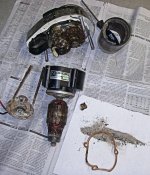journey on
New member
- Joined
- Mar 3, 2005
- Messages
- 3,599
- Reaction score
- 0
- C Dory Year
- 2005
- C Dory Model
- 25 Cruiser
- Hull Identification Number
- TBD
- Vessel Name
- journey on
I don't know that snubbing the anchor rode leads to winch failure. I think that a vertical winch, where the sand, muck and crud fall down into the gearbox and motor, as shown below. That winch was ground to death. Supposedly, the new ones are better.

Still, I'd get a horizontal winch, such as: Lewmar Horizontal Winch.
Boris

Still, I'd get a horizontal winch, such as: Lewmar Horizontal Winch.
Boris
